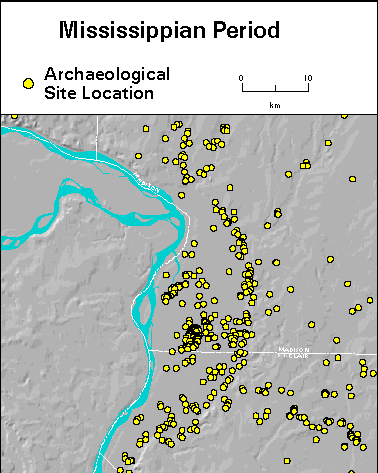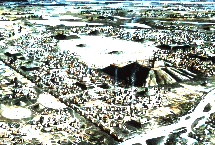Mississippian Settlement
Fields, Wetlands, and Settlement Locations in the American Bottom

Mississippian Mounds, Field, Wetlands, and Settlements
In previous periods there were relatively few site types (fishing camps, hunting stations, cemeteries and residential settlements) and most settlements were small with little or no difference between households. Community and specialized (non-household) structures in villages were rare. Mississippian residential sites, however, fall into at least 4 clear size classes. (1) At the low end of the size range are small farmsteads or hamlets of 2-3 households (families) which are scattered throughout the American Bottom. These family farms were located near other larger settlements. (2) Some villages contained dozens of households. A few of these villages contain not just residential structures, but small, flat-topped mounds. Specialized civic and religious functions took place around these mounds. A local chief or priest who led ritual and civic functions likely lived on top of the mounds as well. (3) Other towns contained more than one mound suggesting some greater importance than smaller settlements with only one or no mounds. (4) Finally, a few settlements contained numerous mounds organized around a central plaza. Not only did these mound centers contain a variety mounds, they apparently were home to many more people than even the largest of Mississippian towns. The largest and most famous of these American Bottom mound centers is Cahokia.
Wetlands and other aquatic habitats were important for aquatic resources as well as for communication and transportation routes. Dry land was necessary for places to live and for fields for crops. The importance of both wetlands and dry land is illustrated by the distribution of mound settlements in the American Bottom. People positioned themselves to gain access to a good mix of both wetlands and aquatic resources and soils suitable for farming. Mounds that mark the places that were most important to prehistoric people exhibit this strong wetlands orientation, as shown by the positioning of large mounds in the Lunsford - Pulcher and Cahokia areas. Furthermore, the high ground alongside wetlands throughout the valley was frequently occupied.  Excavations at Cahokia have shown that structure remnants are heavily concentrated on the crest of ground along the slough that passes through the northern part of the site. The internal organizations of settlements were influenced strongly by the configuration of the natural environment.
Excavations at Cahokia have shown that structure remnants are heavily concentrated on the crest of ground along the slough that passes through the northern part of the site. The internal organizations of settlements were influenced strongly by the configuration of the natural environment.
 Excavations at Cahokia have shown that structure remnants are heavily concentrated on the crest of ground along the slough that passes through the northern part of the site. The internal organizations of settlements were influenced strongly by the configuration of the natural environment.
Excavations at Cahokia have shown that structure remnants are heavily concentrated on the crest of ground along the slough that passes through the northern part of the site. The internal organizations of settlements were influenced strongly by the configuration of the natural environment.
